Surveys - introduction/zh-cn: Difference between revisions
From LimeSurvey Manual
(Created page with "*'''传真:''' 用来在 "可打印调查"上显示传真号码 - 比如: 某些用户无法使用线上调查,而你需要发送一份纸质问卷给他/她。") |
(Created page with "*'''组'''{{新加入|3.0}}''':''' 新建的调查应该加入 调查组 。") |
||
| Line 87: | Line 87: | ||
*'''传真:''' 用来在 "可打印调查"上显示传真号码 - 比如: 某些用户无法使用线上调查,而你需要发送一份纸质问卷给他/她。 | *'''传真:''' 用来在 "可打印调查"上显示传真号码 - 比如: 某些用户无法使用线上调查,而你需要发送一份纸质问卷给他/她。 | ||
*''' | *'''组'''{{新加入|3.0}}''':''' 新建的调查应该加入 [[Surveys - introduction#Survey groups|调查组]] 。 | ||
*'''Format:''' This function allows you to choose the way in which the questions will be displayed to the survey respondents. Three options are available: | *'''Format:''' This function allows you to choose the way in which the questions will be displayed to the survey respondents. Three options are available: | ||
Revision as of 09:07, 27 August 2020
内容列表:
概要
一份调查包括不同的交互连接的数据库: 语言, 问题, 问题组, 问题属性, 子问题, 答案, 默认答案, 评估和配额设置. 为了增强调查管理的功能, 新近加入了调查组 的功能Template:新加入 .
调查
有两种方式打开 创建一个新调查 页面:
1. 第一种方式是点击主页上调查按钮右边的倒三角按钮. 从显示的对话框下拉菜单里选择创建一个新调查.
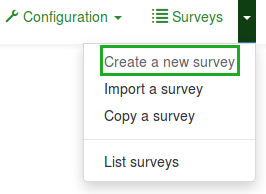
2. 第二种方式是通过主页的大按钮创建.

点击后,一份调查列表会显示出来。要创建一个新的调查,点击调查列表左上角的 创建一个新的调查按钮。

创建一个新的调查
点击 创建一个新的调查后载入新的窗口:
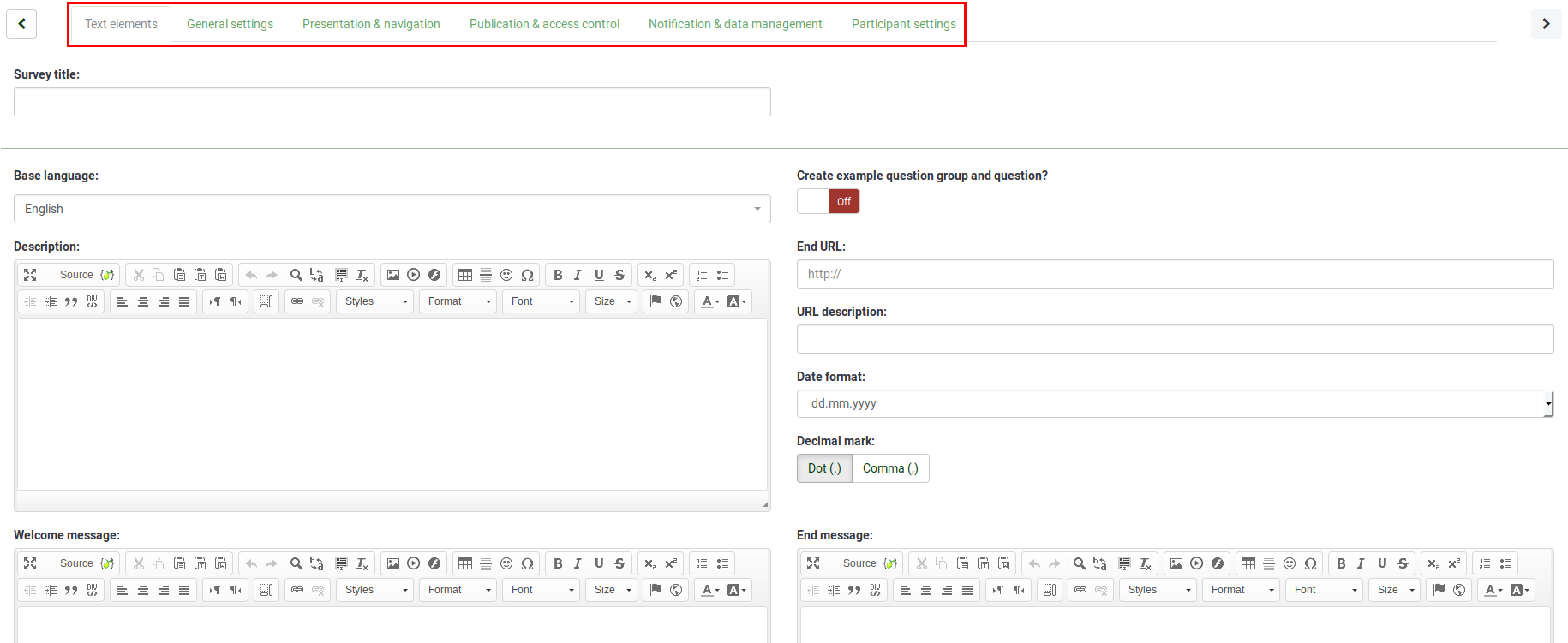
通过位于创建一个新的调查 工具栏的每个标签来完善调查:
文本元素
文本元素的对应选项:
- 调查标题: 更改调查标题.
- 创建示例问题和问题组?:Template:新加入 如果开启此功能,示例问题和问题组会作为默认选项自动加入新建的调查。 点击"保存"按钮后示例问题和问题组会出现。
- 基础语言: 这里呈现的是调查的主要语言。如果你要添加其他语言,首先要创建一个新的调查,然后通过常规设置 添加 附加语言.
- 结束链接: 你可以在用户完成问卷调查表之后将他们引导到一个页面。如果你想这么做,在展示和导航下的自动载入链接中输入要跳转的链接并激活.
- 链接描述: 一个简短的用以对用户被跳转到一个和调查非相关的页面行为的描述。对调查管理员给相关调整加备注有帮助。
- 日期格式: 这个选项对于你想把受访者的答案和 时间戳 一起记录的话很重要。别忘了,各个地域遍布着不同的日期格式,从下拉列表里的多个数据格式中选择你的受访者使用的日期格式。 比如调查问卷是针对美国市场的,要使用美国格式(mm-dd-yyyy),而不是英国格式(dd-mm-yy)。
- 小数点: 有两种可用的选择: 点 (.) 和逗号 (,)。 选择适合你所在地区的教学习惯的格式(比如美国和德国)。
- 欢迎辞: 这段文字是对顺着链接来到你的调查问卷的受访者表示问候。
- 结束信息: 受访者完成问卷调查后会看到的一段话。但如果结束链接是自动载入链接的话,受访者就看不到这段文字。
常规设置
以下选项可以在常规设置下找到:
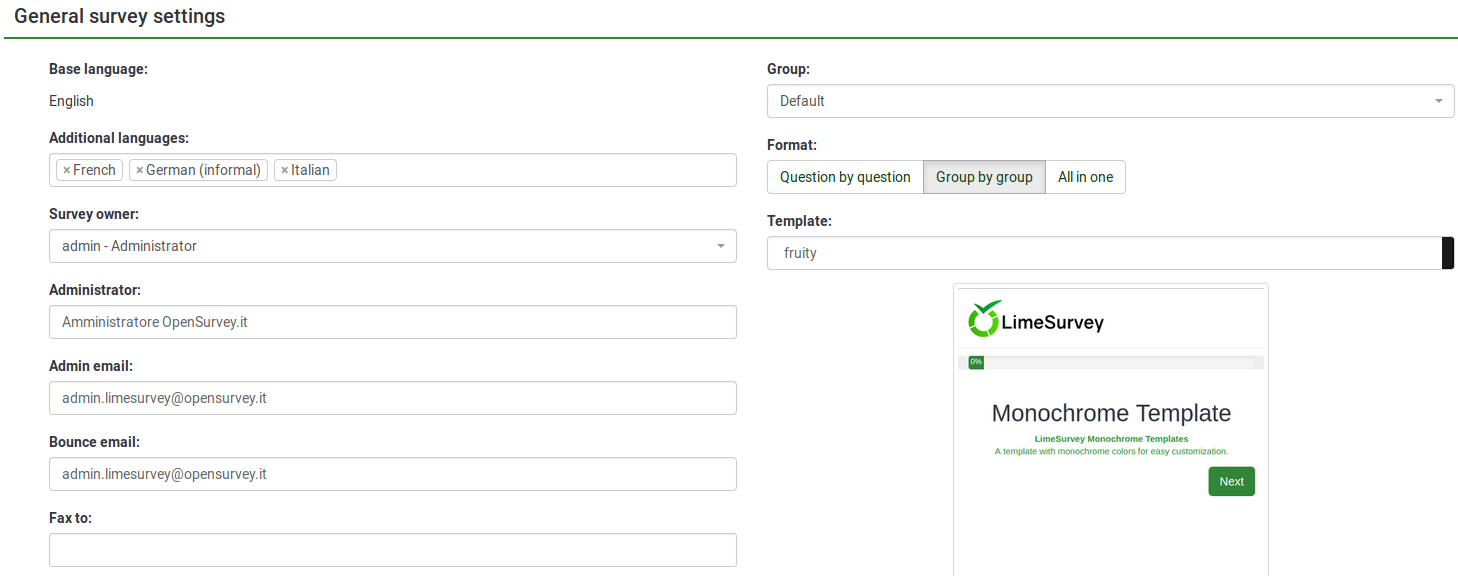
- 调查所有者: 调查所有者的真实姓名。
- 管理员: 管理员的名字。
- 管理邮件: 管理员的电子邮件地址。
- 退信: 发送失败的通知邮件会发到这个地址。
- 传真: 用来在 "可打印调查"上显示传真号码 - 比如: 某些用户无法使用线上调查,而你需要发送一份纸质问卷给他/她。
- 组Template:新加入: 新建的调查应该加入 调查组 。
- Format: This function allows you to choose the way in which the questions will be displayed to the survey respondents. Three options are available:
- Question by Question : The questions will be displayed one by one (one question per page). If this option is chosen, a separate "welcome" page and "end" page will be displayed when taking the survey.
- Group by Group : Each survey page will display a question group. Also, a separate "welcome" page and "end" page will be displayed when taking the survey, as with the "Question by Question" surveys.
- All In One : If chosen, all the pages will be displayed on a single page. If you select this option, no separate pages will be displayed for the "welcome" and "end" pages - they will all appear on the same page, together with the questions.
- Template: The default template is rather simple, but functional. More information on creating your own templates is available here.
The following options can be found under the Presentation & Navigation tab:
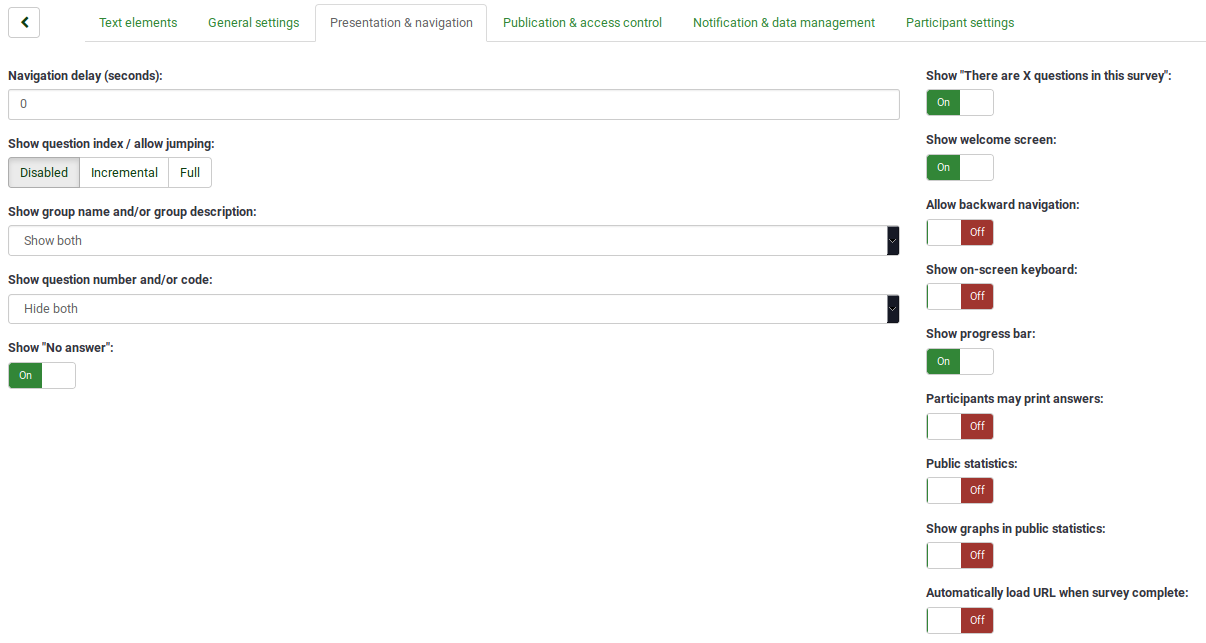
- Navigation Delay (Seconds): This feature displays the number of seconds before the previous, next, and submit buttons are enabled. If none is specified, the option will use the default value, which is "0" (seconds).
- Show Question Index / Allow Jumping: A question index can be displayed in the survey if this function is enabled, allowing the user to jump from one question group to another. You can choose the following:
- Disabled : If this option is selected, no index is shown in the survey.
- Incremental : If this option is selected, the question groups will be shown incrementally in an index menu located on the survey page. You are allowed to "jump back" only to the question groups that were previously visited/accessed.
- Full : Jumping from question group to question group is allowed via the index menu.
- Show "There Are X Questions In This Survey": This shows the total number of questions in your survey.
- Show Group Name and/or Group Description: This function allows you to choose whether your survey will show participants the question group name only, the group description only or both. You may also choose to hide both.
- Show Question Number and/or Code: This function allows you to choose whether your survey will show participants the question number only, the question code only or both. You may also choose to hide both. Please note, the question number is shown the moment someone starts the survey, while the question code is shown next to each survey question.
- Show "No Answer": When a "radio button" or "select type" question that contains editable answers (e.g.: List & Array questions) has the Show "No Answer" option enabled and it is also not mandatory, an additional entry "No Answer" is displayed for each question/sub-question. In this way, the respondents may choose not to answer the respective question/sub-question. The following two options are available for survey administrators:
- On : If this option is selected, the respondents can choose the "No Answer" option for a non-mandatory question.
- Off : If selected, the "No Answer" option will not be displayed as a possible answer for any non-mandatory question.
- Show Welcome Screen: If turned off, the welcome text message will not be displayed at the beginning of the questionnaire.
- Allow Backward Navigation: If enabled, this will allow the users to navigate backwards and change his or her previous answers.
- Show On-Screen Keyboard: If turned on, an on-screen keyboard will will be displayed when answering questions that require typing in information.
- Show Progress Bar: When enabled, this function displays a progress bar that shows participants how much of the survey they have completed and how much is left to be completed.
- Participants May Print Answers: If turned on, the survey participants may choose at the end of the survey to print their answers.
- Public Statistics: A link to a set of statistics will be shown at the end of the survey if this option is enabled.
- Show Graphs In Public Statistics: If enabled, graphs will also be shown in the Public Statistics at the end of the survey. Please note that the "Public Statistics" option has to be enabled to allow the survey participants to see the graphs.
- Automatically Load URL When Survey Complete: The end URL becomes a redirect link once the survey is completed if this option is turned on.
Publication & access control
The following options can be found under the Publication & Access Control tab:
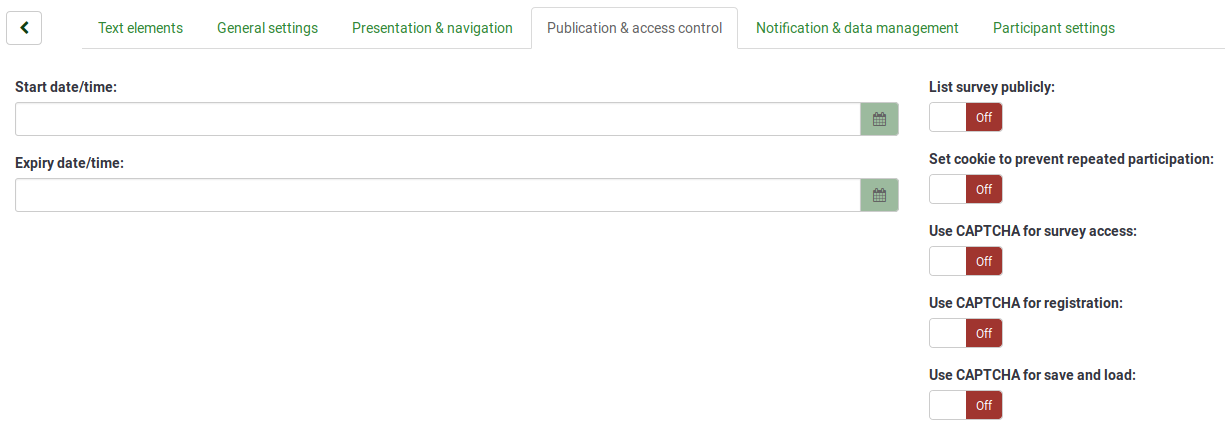
- Start Date/Time: This is the date/time the survey starts.
- Expiry Date/Time: This function allows you to choose a date for your survey to expire. This is the last date on which the public survey script will let people participate. (Example: If you set the expiry date for the 31st of December, then people will no longer be able to fill out the survey on the 1st of January). To remove an expiry date, just clear the date from the input field.
- List Survey Publicly: The default value is "No". When it is set to "Yes", your survey will be listed in the "Available Surveys" portal where it can be seen by all LimeSurvey users.
- Set Cookie to Prevent Repeated Participation: If this is turned on, a survey participant will be blocked from completing a survey a second time.
- Use CAPTCHA for Survey Access: In order to access the survey, a CAPTCHA code has be typed in by the survey participant.
- Use CAPTCHA for Registration: In order to register for the survey, a CAPTCHA code has be typed in by the survey participant.
- Use CAPTCHA for Save and Load: Enable this function if you want a survey participant to type in a CAPTCHA code when he or she loads the survey again after only a part of it was completed.
Notification & data management
The following options can be found under the Notification & Data Management tab:
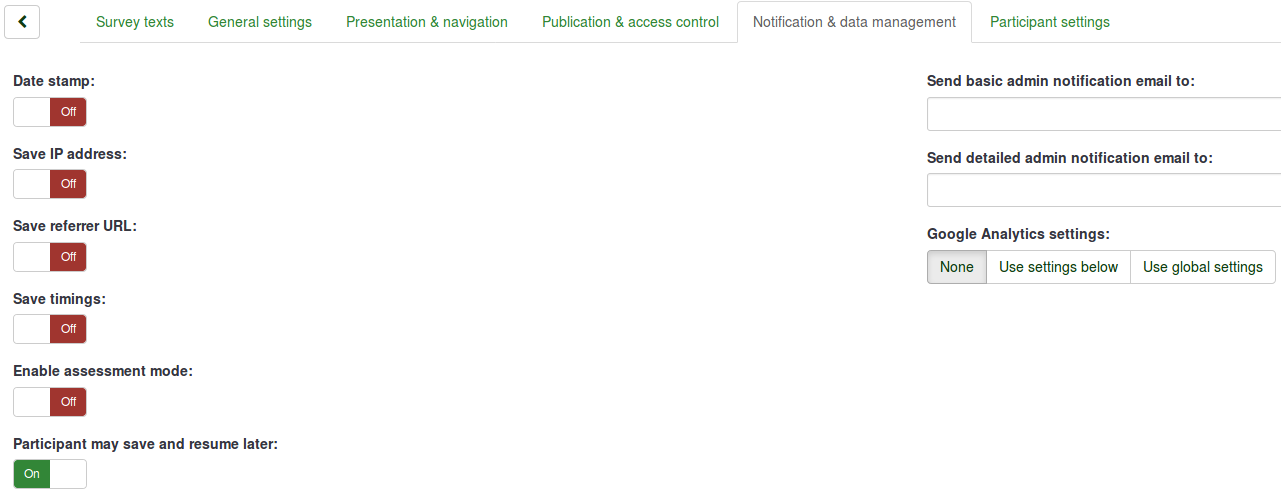
- Date Stamp: Enable this functionality if you would like to see the time when the answers were submitted.
- Save IP Address: If "yes" is selected, the IP address of the survey respondent will be stored together with his or her answers.
- Save Referrer URL: If "yes" is selected, the referrer URL will be stored together with the answers.
- Save Timings: If this functionality is enabled, the time spent on each page of the survey by each participant is recorded.
- Enable Assessment Mode: You can enable/disable assessments for this survey with this setting.
- Participant May Save and Resume Later: This setting allows a participant to save his/her responses and resume the survey at a later time. Please note that this is most useful with open surveys or surveys in which the participants are anonymous. If you are using tokens and the survey is not anonymous, in most cases it is better to activate token-based response persistence from the Participant settings panel.
- Send Basic Admin Notification Email To and Send Detailed Admin Notification Email To: These two functions allow you to send notifications or survey responses to any email address once the survey is submitted. You can edit the templates for these emails from the Email templates menu. You can choose the option to send emails to multiple recipients simultaneously by separating the email address entries with a semicolon (;) (e.g "yourname@test.com; myname@test.com; hisname@test.com" or (if using placeholders) "yourname@test.com;{INSERTANS:82733X12X73};{TOKEN:EMAIL}").
There are different ways for entering an email address:
- Enter a specific email address (ie: yourname@test.com).
- Enter a SGQA code and the response will be sent to an email address entered as an answer to that particular question (use the format {INSERTANS:9999X88X12} in the same way you would reuse information from previous answers).
- The following is only possible if your survey is not anonymous. Enter a token code and the response will be sent to an email address retrieved from a token field. Use the format {TOKEN:EMAIL} or {TOKEN:ATTRIBUTE_1} in the same way you would re-use Information from the Survey participants table.
- Google Analytics Settings: If you would like to get details about the survey web traffic, use Google Analytics. Three options are available:
- None : Google Analytics will not be used.
- Use Settings Below : If this option is chosen, the survey owner can type in his or her Google Analytics Tracking ID to be stored only with the respective survey. You also have the ability to choose one of the three Google Analytics styles.
- Do Not Use Google Analytics - so {GOOGLE_ANALYTICS_JAVASCRIPT} is an empty string.
- Default Google Analytics - {GOOGLE_ANALYTICS_JAVASCRIPT} uses the standard Google Analytics code, inserting the proper Google Analytics Key.
- SurveyName-[SID]/GroupName - {GOOGLE_ANALYTICS_JAVASCRIPT} contains customized Google Analytics code to log the URL as {SURVEYNAME}-[{SID}]/{GROUPNAME}. This can be helpful if you want to analyze navigation paths through your survey, time spent per page, and drop-off rates per page.
- Use Global Settings : If this option is chosen, the survey will use the same Google Analytics Tracking ID as the one saved in the global settings and then you choose the desired Google Analytics style.
Participant settings
The following options can be found under the Participant Settings tab:
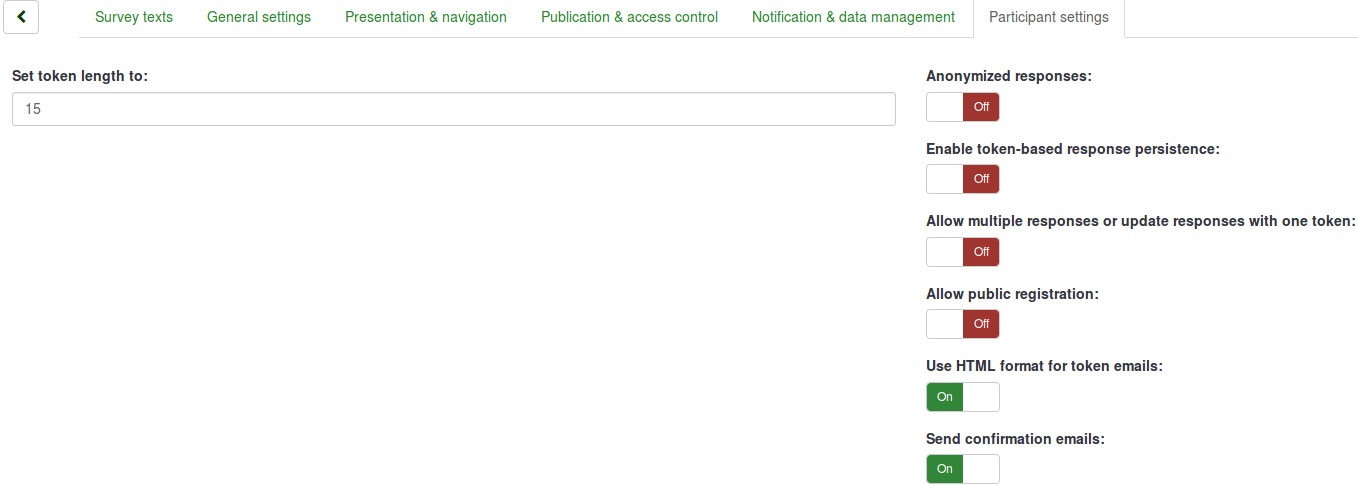
- Set Token Length To: Usually, the default value of 15 digits does not need to be changed (the maximum supported value is 35). However, if you wish to change this setting, please enter a number (X) which is greater than 5. If the number entered is less than 5, it will be converted to the default value of 15. When generating tokens, all tokens will use a length of X digits.
- Anonymized Responses: This functionality allows you to determine whether responses to your survey are matched with information from the Survey Participants table (utilized in the respective survey) or are kept "anonymous". The default is "No". If you choose "Yes", then your survey is set to anonymize responses - there will be no way to connect answers and participants. Even the survey administrator will not be able to link response data and participant/token data. However, you will always be able to specifically view each response entered by your participants in the survey. Thus individual and anonymous analyses can still be done.
- Enable Token-Based Response Persistence: If your survey uses tokens and your responses are not anonymized, you may want to enable this feature. If you enable this feature, your participants will be able to leave the survey and resume later at any time without using the Resume Later function - for example, when they get distracted or their browser crashes. Upon clicking the invitation link again, they will be returned to the point in the survey where they left off with previous entries saved.
- Allow Multiple Responses or Update Responses With One Token: If this option is activated, participants will be able to return to their survey by clicking the invitation link, even if they have already submitted the survey. If the survey is anonymous or "Enable Token-Based Response Persistence" is set to "No", this will add a new response. If the survey is not anonymous and "Enable Token-Based Response Persistence" is enabled, the user will update the existing responses.
- Allow Public Registration: If you use tokens to control access to your survey, the only people who can use the survey are those who have an entry and a unique token code allocated in the Survey participants table. If you would like to use tokens, but also allow public registration, set this to "Yes". The "Yes" setting will allow visitors to register his or her name and email address. The script will create a new entry in your Survey Participants table for this person, then send them an invitation email. The script will ensure that only one person per email address can complete your survey.
- Use HTML Format For Token Emails: When enabled, all emails sent by the token management interface (invite, reminder, confirmation) will be formatted as HTML. You will then be able to use rich formatting for these emails. The default value is "Yes".
- Send Confirmation Emails: If enabled, the participant will receive a confirmation email that the survey was submitted.
Import a survey
If you wish to import a survey, you can do that from the "Create, import, or copy survey" screen. To get there, click the Create, import, or copy a survey button and then on the Import tab. Next, click on browse to choose the file you wish to import, and then on the Import survey button.

The import process reads the following formats:
- .LSS files (XML-format created by LimeSurvey 1.90 or later);
- .LSA files (Survey archive which may include also token, responses and timings - available since LimeSurvey 2.0);
- .TXT files (Text-format created by Excel - available since LimeSurvey 2.0);
- .CSV files (Created by early LimeSurvey versions from 1.50 to 1.90).
The import function "intelligently" re-numbers the survey, groups, questions, answers, and condition IDs so that they all match each other. No existing survey is going to be overwritten during the import process.
By default, the resource links and expression fields are also imported. Basically, the more advanced type of questions are going to be also imported along questions that include complex branching, assessments, validation, and tailoring.
Once the import process is completed, a survey structure import summary will be displayed, showing whether it was successful or not:
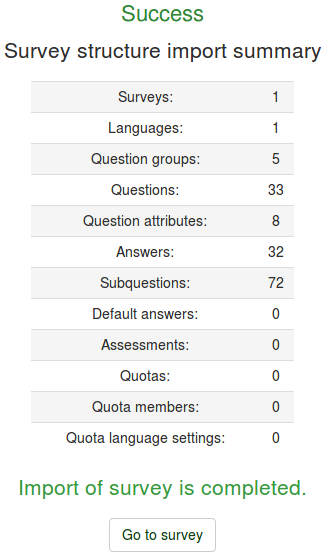
Copy a survey
The last tab contains the copy survey functionality and its options:
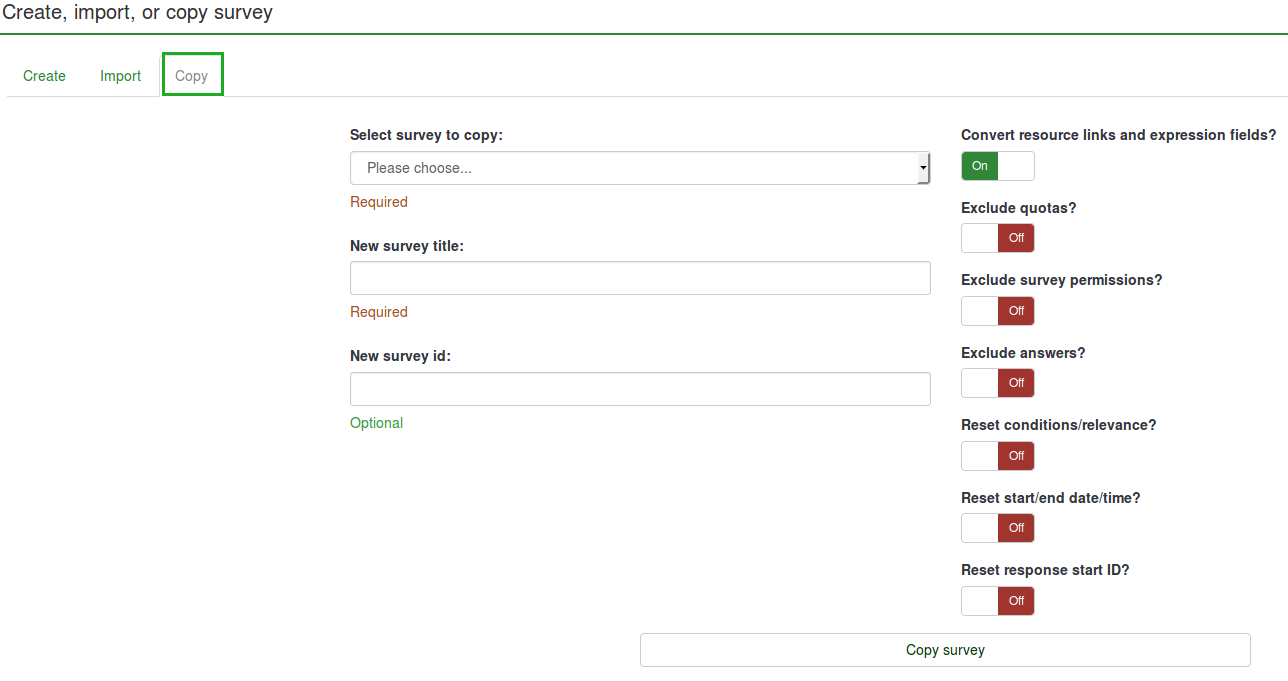
- Select survey to copy: Select the survey that you want to copy from the drop-down list.
- New survey title: Type in the title you wish the copied survey to have.
- New survey id: You can type in a new survey ID or leave the field empty. If the field is left empty, a survey ID will be automatically assigned.
- Convert resource links and expression fields: If you disable this option, the more advanced question types that use the expression manager will not be copied.
- Exclude quotas: The quotas are going to be excluded if this option is disabled.
- Exclude survey permissions: If enabled, no survey permissions will be copied into the new survey.
- Exclude answers: Exclude the answer options.
- Reset conditions/relevance: You can choose to reset the conditions that were set in the original survey.
- Reset start/end date/time?: You can choose to reset the survey start/end date/time.
- Reset response start ID?: Each response has a corresponding ID. If enabled, the ID of the responses will be reset. However, bear in mind that it is better not to have an ID with two matching responses because it might influence the output of your survey.
Once you are done selecting the prefered options, click on the Copy survey button located on the bottom of the page. A survey copy summary will be displayed:
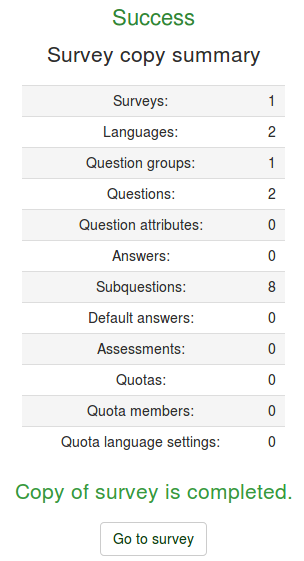
To access the copied survey, click Go to survey to be redirected to the settings of the newly added survey.
List surveys
There are now two ways to see a list of available surveys: (1) Choose "List surveys" from the drop-down list at the top of the LimeSurvey home page. (2) Click the "List surveys" box on the LimeSurvey homepage.

- Survey ID: When created, the survey receives a unique id that is used to make the connection between different LimeSurvey tables.
- Status: Status of available surveys:
- Title: The title of the survey.
- Group: The survey group to which the survey belongs to.
- Created: The date when the survey was created.
- Owner: The name of the user that owns the survey.
- Anonymized responses: This shows whether the responses are anonymized when stored into the database or not.
- Partial: The number of surveys that were partially completed.
- Full: The number of surveys that were fully completed.
- Total: The number of partially and fully completed surveys.
- Closed group: This is either "Yes" (if a Survey participants table is used) or "No".
- Actions: The last column presents the actions that are available for each survey:

If you want to look for a specific survey, use the search bar and filter the results via the survey status field ("active", "active and running", "inactive", "active but expired", and "active but not yet started").
Delete a survey
In order to delete a survey, you have to first access the survey list page. Then, select the survey(s) you wish to delete (by ticking the box to the left of the survey ID) and click on the Selected survey(s)... button located on the bottom-left side of the page:
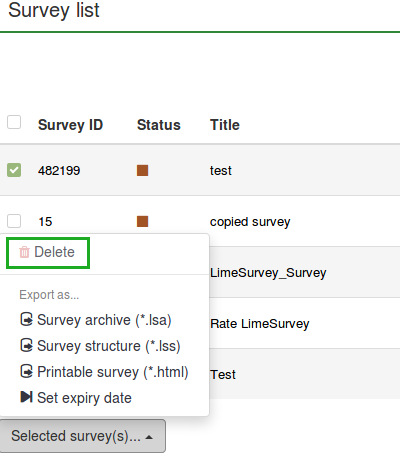
When you click Delete, a confirmation window will pop up in order to confirm your action.
Export a survey
If you want to export a survey, you have to access the survey list table and select the survey(s) by ticking the box to the left of the survey ID that you wish to export:
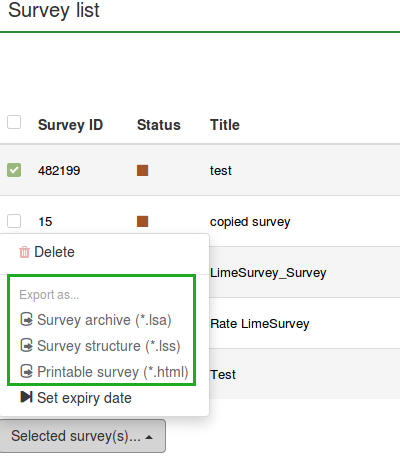
The following options are available:
- Survey archive (*.lsa);
- Survey structure (*.lss);
- Printable survey (*.html): This option allows you to export the survey in a printable format in order to be filled out "offline".
For more details, check our wiki section on how to export a survey structure.
Survey groups
In order to access the survey group functionalities, click on the Surveys button located on the main toolbar of the LimeSurvey home page. Then click the Survey groups tab:

A survey groups list will be displayed.
On this page you can:
- Create a survey group - located above the survey groups table;
- Edit a survey group - located on the last column (the green pencil icon);
- Delete a survey group - located on the last column (the red trash icon).
Create a survey group
To add a new survey group, click on the Create a new survey group button located above the survey groups list. The following columns have to be filled in:
- Name: Type in the name of the survey group;
- Title: Type in the title of the survey group;
- Description: Type in a short description of the survey group;
- Order: Helps you organize the order of the survey groups within a parent group;
- Parent: Choose the survey group that will be the parent survey group. The parent group option is used to ease the edit of template-related options of a high number of survey groups via a few clicks.
To add surveys to the group you will need to visit the "General settings" tab inside a survey and under "Group" select the survey group.
Edit survey group
The following options of a survey group can be edited:
- Surveys in this group;
- Settings for this survey group;
- Template options for this survey group (New in 3.0 ).
Surveys in this group
If you click on the first tab, all the surveys from the respective group will be displayed.

This works as a filtering function, filtering out all the surveys not listed in the chosen survey group. You can now select the desired survey and start editing it. To see which survey-editing functionalities are available, check the list surveys section.
Settings for this survey group
The following fields can be edited from the Settings for this Surveygroup tab:
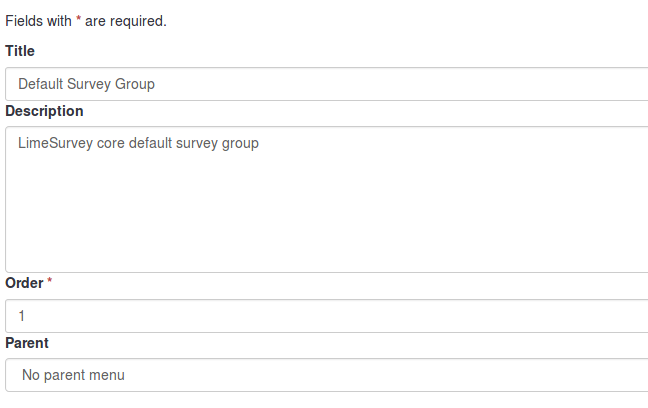
- Title: Type in the title of the survey group;
- Description: Type in a short description of the survey group;
- Order: Helps you organize the order of the survey groups within a parent group;
- Parent: Choose the survey group that will be the parent survey group. The parent group option is used to ease the edit of template-related options to a higher number of survey groups via a few clicks.
Template options for this survey group
The template options functionalities are present in LimeSurvey 3.0+. It offers a set of various options that allows you to quickly and easily change the templates-related settings of the surveys that belong to the same survey group:
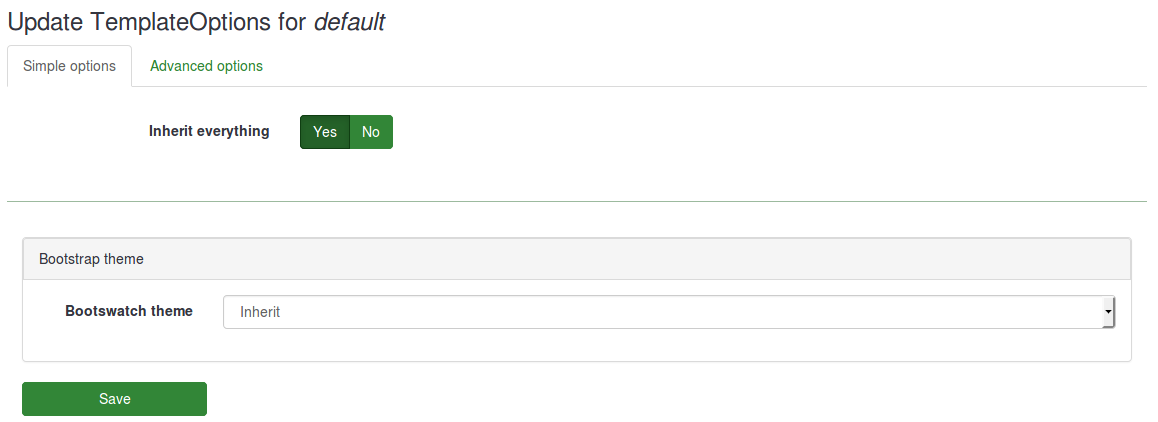
The Inherit everything functionality lets you decide whether you want the survey group to inherit everything or not from the parent survey group theme.
If you do not want this to happen, select "No". The following options will show up which will allow you to choose what should be inherited from the parent survey group theme:
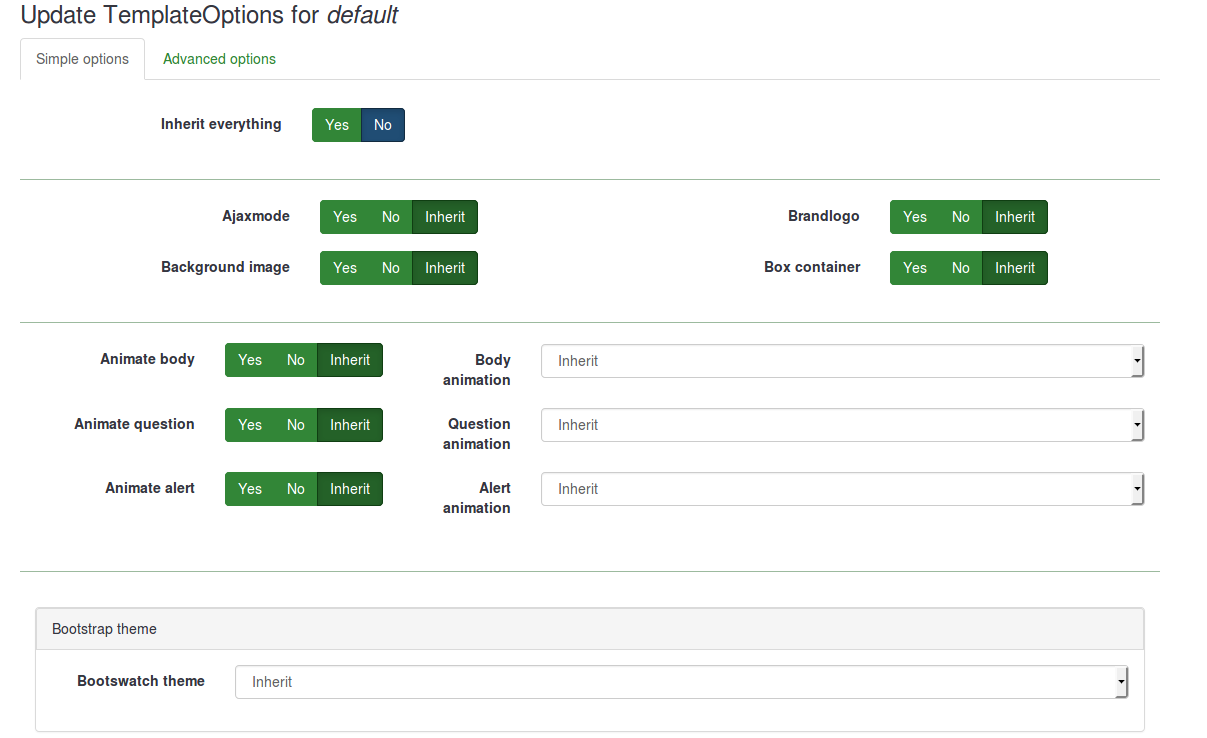
Below, you will see that you can choose a bootswatch theme for your survey group. Bootswatch themes can be used to quickly edit your templates. Basically, bootswatch is a collection of themed swatches which can be freely downloaded and dropped into your Bootstrap site. Some of these themes are already included into your LimeSurvey installation and they can be selected from the Bootswatch theme drop-down list.
If you want to tweak more a survey group template options, click on the advanced option tab (recommended for advanced users):
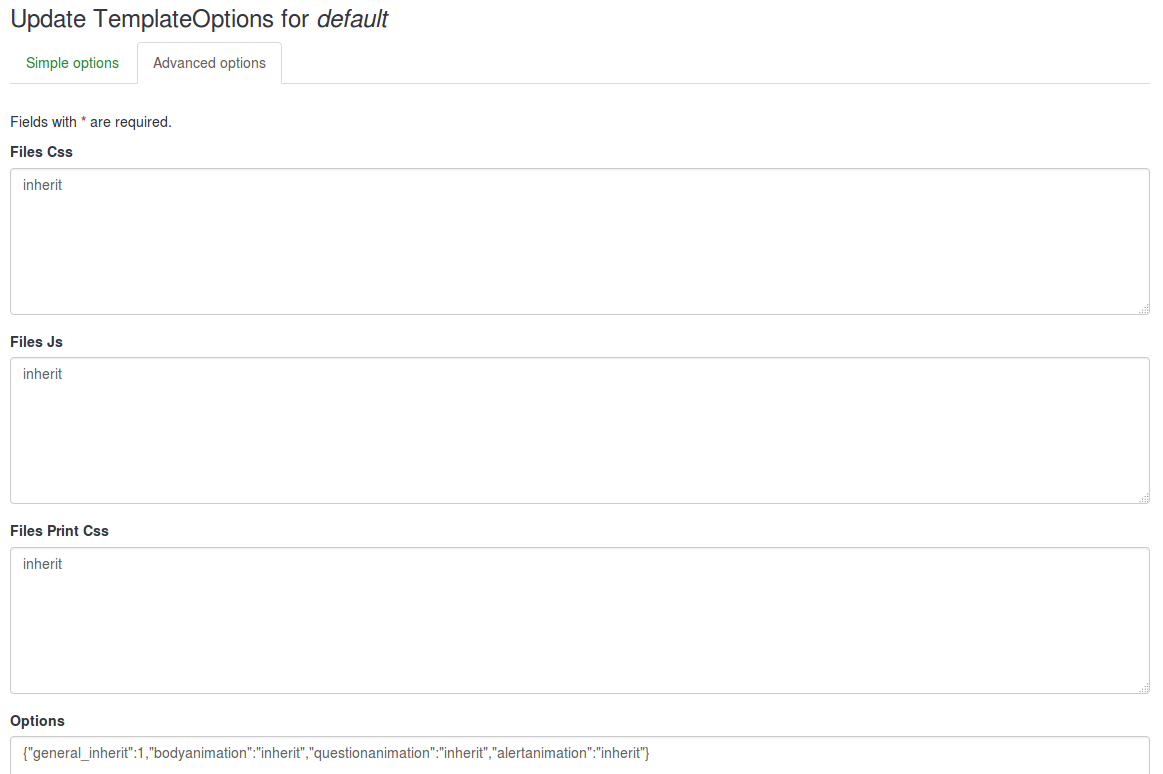
Delete a survey group
To delete a survey group, select the survey group you wish to remove and click on the red trash button located in the last column. Then, confirm the deletion.